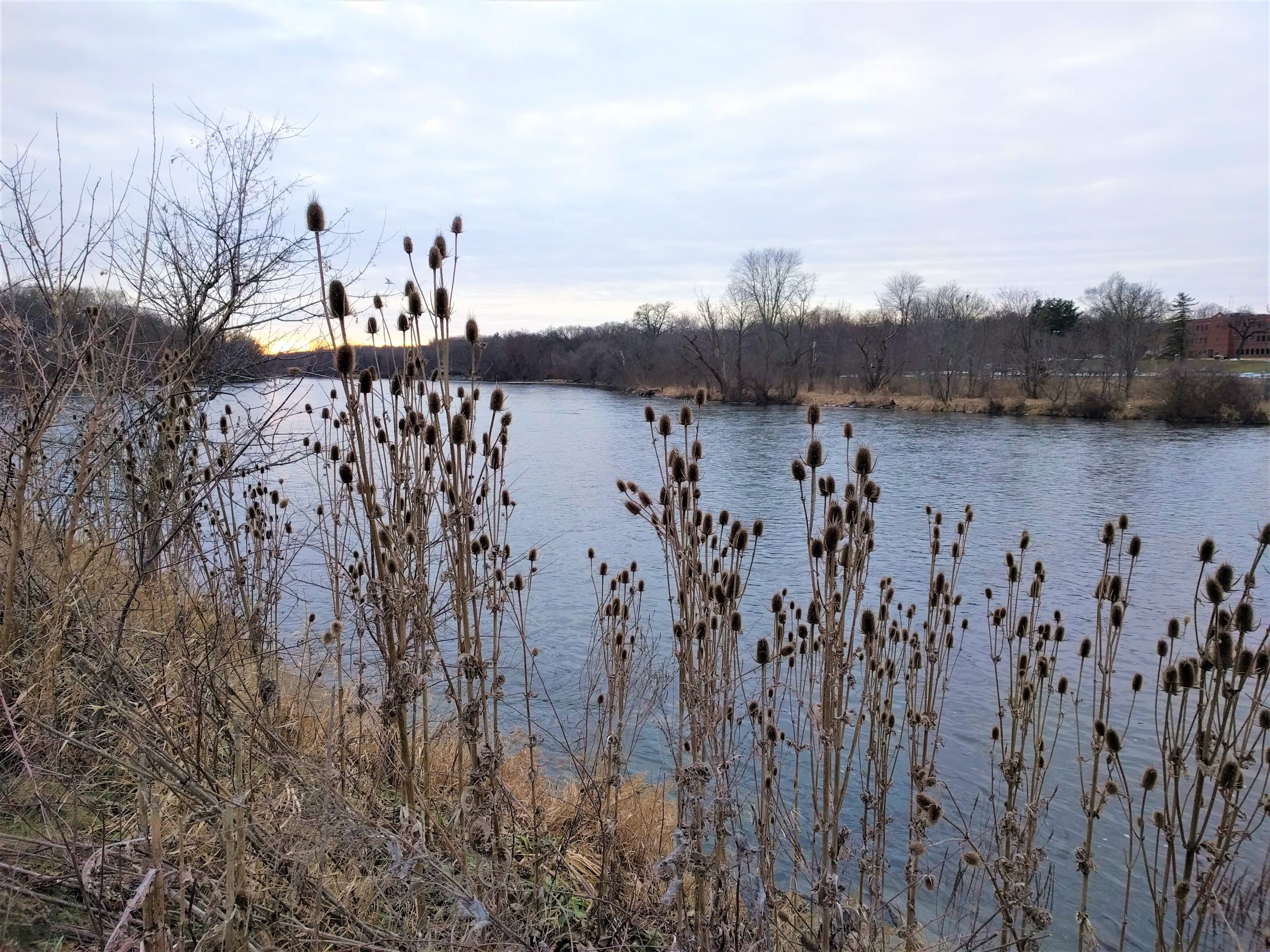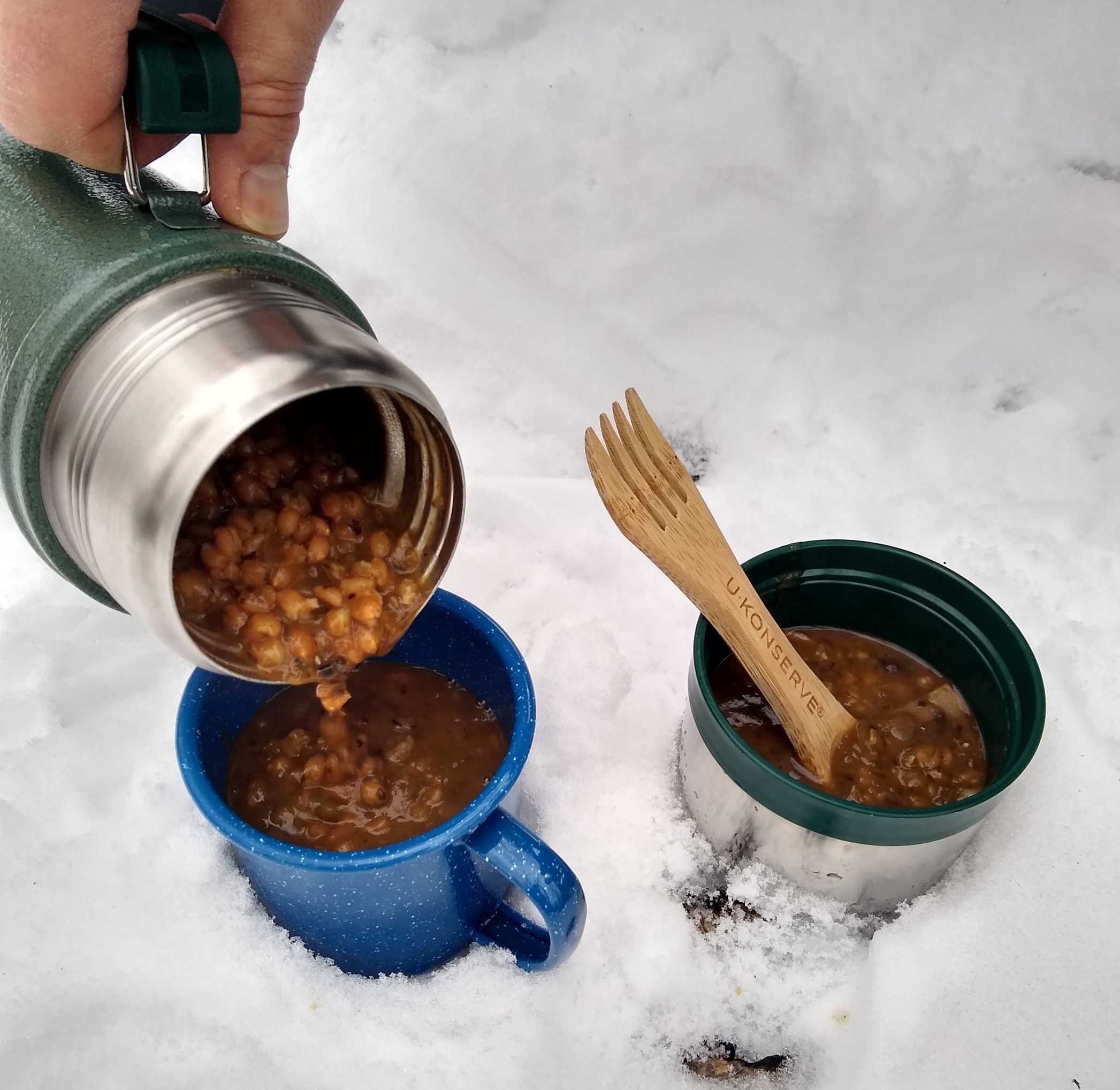Winter hiking in Chicagoland: What to bring, where to go, and how to boost your comfort

Winter can make you feel boxed in and shut off from the world. This is particularly true if you live in a sprawling metro region like Chicago, where it’s not always obvious where you can get outside and connect with the natural world.
Going for a hike during a Midwestern winter is full of intriguing sights, sounds, and color. There’s much to enjoy if you’re patient and willing to look for it. For example, I like to hike after a recent snow fall to experience the profound stillness of the landscape. I also enjoy how fresh snow reveals the bustling neighborhoods within the woods thanks to the imprints left by paws, hooves, and claws.
While researching four editions of my book 60 Hikes within 60 Miles: Chicago and writing about local hiking destinations for Backpacker magazine and other publications, I’ve learned a fair amount about cold weather hiking in the Midwest and in the Chicago region in particular.
Here are a few tips that may help you get the most out of your winter hikes.
INJECTING MORE FUN INTO THE EXPERIENCE
Warm up with a bonfire. Bonfires can make a winter outing memorable… and warm. There are a few fire pits along the lakefront parkland in Chicago, or, for the price of one night at a campground, you can have your very own fire pit. Campsites in local state parks and forest preserves are always cheaper in winter, and you certainly don’t have to stay the night.
Consider going off-trail. One of the many pleasures of hiking in winter is to literally go off the beaten path. While you can hike off-trail in any season, winter makes it easier because there’s less vegetation to contend with and much longer sight lines, giving you more to see.
Find your way while hiking off-trail:
- Download a mapping/GPS software app like Gaia or Caltopo to your smart phone.
- While on the hike, look for a prominent feature on the map as your goal — like a pond, a stream, or a bluff.
- Compare the topo map to the terrain; look for landscape features that will help guide you to the destination.
Consider trying off-trail exploration at Palos Forest Preserve in the southwest suburbs. It offers some big open spaces with plenty of variety in the terrain, but you’ll never be more than a mile or so from a trail or a road.
If snow is more than 5-6 inches deep while hiking off-trail, consider wearing gaiters, snowshoes, or both (gaiters are sheaths of nylon that wrap around your ankle and calf to prevent snow from entering your boots).
Look for critter tracks. If you happen to take a winter hike not long after a fresh layer of snow has fallen, you’ll realize that you’ve been fooled into equating winter with total dormancy. Fresh snow soon gets crisscrossed by an array of critters: raccoons, foxes, coyotes, rabbits, chipmunks, deer, and a variety of birds. Guidebooks focusing on animal tracks in the Midwest can be fun to bring along. You don’t have to see animals to enjoy their presence.
EXPECT A SLOWER PACE, SHORTER DAYS
If you’re accustomed to hiking a certain distance during the rest of the year, you’ll soon learn that winter requires an adjustment of expectations.
Hiking in winter is slower because you’re regularly stopping to adjust your outwear, you’re carrying more clothing and gear, and you’re likely packing a heavy thermos. Combine that with trails covered in snow or ice and you’ve got a much slower pace.
Because the days are short at this time of year, I like to get out early. It’s when you’ll most likely see animals on the move and it allows you to avoid the experience of racing back to the trailhead as dusk sets in.
WHAT TO BRING
Hot drinks and hot soup. It’s difficult to overstate the satisfaction that comes with enjoying a thermos of hot chocolate or a hearty soup during a cold weather hike. Nothing short of a profound pleasure.
Sure, you’re carrying some extra weight with a thermos and an insulated food container. Trust me — it’s well worth the extra pound or two.
On the subject of food and snacking in winter: bring more food than you think you’ll need.
Extra insulation. It’s not uncommon for me to bring 2-3 pairs of gloves or mittens when hiking in winter. If one pair gets wet, or one pair proves to be too warm or not warm enough, I have options. Same with hats.
In extreme cold, I typically pack chemical warmers in case I get cold hands and a couple of plastic bags to be worn between my sock and shoe, if my feet get cold. The best bet is to choose waterproof, insulated footwear that is comfortable for walking.
You’ve likely heard advice about layering countless times. Here it comes again. As you heat up from movement, layering allows you to shed insulation, stay comfortable, and prevent overheating. It’s difficult to fine tune your warmth with a single puffy jacket.
Still, I nearly always bring a down jacket when hiking in winter, not for hiking in, but for donning while I’m sitting down for hot chocolate or hot soup. It’s lightweight and highly compressible.

A sit pad. Sitting while eating or drinking a warm beverage is an essential part of my time outside in cold weather. Since chances are good that most surfaces you’d want to sit on in winter — like the trunk of downed tree — are cold, wet, or both, a sit pad can make the experience much more comfortable.
For a backside cushion, I’ve use gardening kneeling pads, bubble wrap postal mailers folded in half, fleece pullovers, and a dedicated backpacking sit pad. While the featherweight $100 backpacking chair is supremely comfortable, it may need some insulation on very cold days.
Maybe ice cleats; probably not snowshoes. Given the heavy use of the parks and forest preserves in Chicagoland, the snow on trails is quickly packed down by people walking on them before you. During many years of winter hiking in Chicagoland, the times I wished I had snowshoes on my feet have been rare.
If you’re the first person using a trail after a heavy snow, snowshoes will be useful. Likewise, if you’re going off trail and the snow is more than 8 inches deep.
More often, though, you’ll find that ice cleats are useful. Ice cleats are a traction device that attach to the bottoms of your shoes. If there’s a chance your trail is icy, consider bringing these along.
If you’re interested in trying snowshoeing, here’s a list of rental options.
BE SAFE AND COMFORTABLE
Watch the weather. Knowing the weather forecast is arguably more important during the winter. Will the temperature drop precipitously as the day wanes? Will snow turn to rain? Did I bring outerwear for expected changes in weather?
Pack a small first aid kit. I always take a small first aid kit with me and am very intentional about what makes it into the kit. After taking a two-day wilderness first aid class, I’m ready to help if I encounter someone who needs basic first aid on the trail.
While it’s not a first aid item, I’ll sometimes bring a headlamp while hiking in winter just in case I’m caught after dark — particularly if I’m hiking at an unfamiliar place.
Charge your devices. Is your phone fully charged? Remember that a cell phone loses its charge more quickly in cold weather.
Share your plan. If hiking alone, does someone else know where you’re going? It can be as simple as text message sent to a friend or relative stating where you’re going and how far you’re hiking. This practice is important year-round, but even more so during the winter.
Get to know the park staff. Park staff are an underused resource with a well of knowledge. Give them a call in advance to ask questions like where to spot the animals and birds in the park, which trails might be closed or especially icy, which trails might be best for kids, and the hours of the visitor center.
Check if park is closed for hunting. A handful of Chicagoland parks shut down for a few days during winter for hunting. Among those parks are Chain O’ Lakes State Park, Goose Lake Prairie State Natural Area, Kankakee River State Park, Matthiessen State Park, Midewin National Tallgrass Prairie, Moraine Hills State Park, Silver Springs State Park, and Volo Bog State Natural Area.
CHOOSING DESTINATIONS
Here are some rules of thumb:
Let the weather guide you. During the winter, I often let the weather dictate the destination. On a blustery winter day in Chicagoland, I head for places that are heavily wooded, offering more protection from cold wind.
There are dozens of excellent spots that fit this description, but some of my favorites are the Morton Arboretum in central DuPage County, Edward Ryerson Conservation Area in southeastern Lake County, Marengo Ridge Conservation Area in western McHenry County, and Pilcher Park, just east of Joliet.
If the air is still and if the sun is shining, I might gravitate toward hiking in places that are partially or fully exposed like the Indiana Dunes, Goose Lake Prairie State Natural Area southwest of Joliet in Grundy County, Glacial Park Conservation Area in northeastern McHenry County, and Illinois Beach State Park in the northeastern corner of Lake County. Why not grab all the sun you can in winter?

Consider a destination with a visitor center. Do you want to go somewhere where you can step inside and warm up, or do you have hiking companions who’ll enjoy a kid-friendly visitor center?
Again, good options abound, but some of my favorite hikes with engaging visitor centers are Fullersburg Woods in eastern DuPage County, Little Red Schoolhouse Nature Center in southwestern Cook County, and the Crabtree Nature Center in northwestern Cook County.
For the ultimate post-hike experience, head to the Morton Arboretum or Chicago Botanic Garden to combine your hike with visit to an on-site café with a nice view.
Natural surface trails vs multi-use trails: Know your preference. Natural surface trails are often narrow, more intimate, and winding — a classic hiking trail. They tend to be quieter, and since they typically have a natural dirt surface, you’re more likely to encounter mud, slush, and puddles while hiking in winter.
Multi-use trails are built for a wider variety of users — people walking, biking, running, and riding horses, as well people using wheelchairs and strollers. They tend be busier, more road-like — straighter and wider — with edges of the trail cleared as well. They are graded and topped off with crushed stone or asphalt, which drains the water, reducing the likelihood of mud and puddles.
RECOMMENDED WINTER HIKES
Most local hiking destinations will be as enjoyable in the winter as they are the rest of the year. Still, there are some that stand out because of their scenery, well-marked and maintained trails, and special attractions during the winter.
Starved Rock and Matthiessen State Parks. While these two parks require a 90-minute drive from Chicago, they’re both well worth a day trip. Only two miles apart, these parks are places where you can experience dramatic sandstone canyons with cascading waterfalls that freeze in the winter, creating intriguing ice sculptures.
While Starved Rock State Park is much larger with more opportunities to see canyons and frozen waterfalls, it also has the distinction of being the busiest park in the state. Even during the winter, you’ll encounter plenty of fellow cold-weather hikers, especially during better weather and especially on the trails closer to the main parking area.
During late January, Starved Rock hosts big gatherings of bald eagles. During one January hike, I counted 61 bald eagles from the viewing platform overlooking the Starved Rock Dam on the Illinois River. More than once, I’ve combined a day of hiking or cross-county skiing at Matthiessen State Park (ski rentals a available) with a visit to the viewing platform at Starved Rock for eagle watching.
Palos/Sag Valley Forest Preserve. When the foliage drops away in the fall, you lose the green buffer that makes you feel removed from hubbub that surrounds some parks. This may sound like a minor inconvenience, but many people, including myself, prefer hiking without houses, industry, or loud traffic continually cropping up in the background.
As the largest roadless area in the Cook County, Palos/Sag Valley Forest Preserve feels quite remote for being less than 30 minutes from downtown. With 35 miles of both natural surface and multi-use trails and 14,000 acres of woodland, lakes, ponds, prairies, and rugged glacial terrain, this place offers plenty of buffer.
If you’re interested in venturing off trail, Palos’ big expanse is enticing, allowing you to see the landscape from a vantage point that trail users don’t get to see.

North Chicagoland. Chain O’ Lakes State Park has a bit of everything: Fox River, Grass Lake, as well as prairie, woodland, and wetlands — too much to cover in a single day. During the summer, this park is bustling with boaters and campground visitors, but during the winter it’s extremely quiet.
Just south of Chain ‘O Lakes, and also situated on the Fox River, Moraine Hills State Park is similarly large with a delightful mix of scenery. There’s a lake, a bog, rolling hills, and many miles of multi-use trails.
Where do you hike in winter? Have some tips on making winter hiking more enjoyable or local destinations you’d recommend for winter hiking? Email me and I might add your tip to this article (with credit, of course).
______________
 Through his books and speaking appearances, Ted Villaire has helped many thousands of people get outside and connect with the natural world in the Prairie State. He’s the author of 60 Hikes within 60 Miles: Chicago, Best Bike Rides Chicago, Road Biking Illinois, Best Rail Trails Illinois, and Camping Illinois. Get in touch at ted@tedvillaire.com.
Through his books and speaking appearances, Ted Villaire has helped many thousands of people get outside and connect with the natural world in the Prairie State. He’s the author of 60 Hikes within 60 Miles: Chicago, Best Bike Rides Chicago, Road Biking Illinois, Best Rail Trails Illinois, and Camping Illinois. Get in touch at ted@tedvillaire.com.